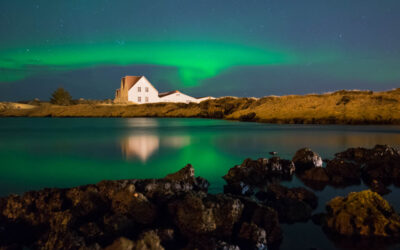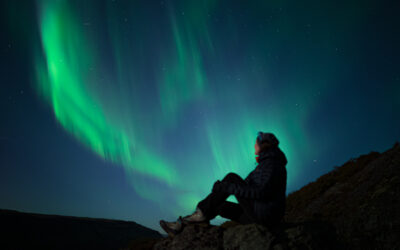VOLCANIC ERUPTION AT REYKJANES PENINSULA – IT IS SAFE TO TRAVEL TO ICELAND
Are you planning a trip to Iceland but are worried about the current eruption on Reykjanes peninsula?
Here’s all you need to know!

WHAT IS HAPPENING
A new volcanic eruption has started at Reykjanes peninsula on Dec 18th, 23.10. The eruptive fissure is about 4 km long, with the northern end just east of Stóra-Skógfell and the southern end just east of Sundhnúk. The distance from the southern end to the edge of Grindavík is almost 3 km.
The Icelandic Meteorological Office continues to monitor the activity and is in direct contact with civil protection and response units in the area.
A NEW GEOLOGICAL PHASE
Earthquakes and eruptions are not a rare occurrence in Iceland, due to Iceland’s location on the Mid-Atlantic ridge.
Ever since 2021, Reykjanes peninsula has witnessed a new geological phase, with 3 eruptions in 3 years, the first ones in the area in about eight centuries.
The 2021, 2022 and summer 2023 eruptions all took place in uninhabited areas of the peninsula and posed no threat to life nor infrastructure in the area.
LIMITED AREA AFFECTED
It is important to stress that the area affected by the current volcanic unrest is limited to a small portion of Reykjanes peninsula, spanning only a few kilometers.
Road closures have been enforced and no traffic is allowed to enter the area considered at risk.
For precaution, the worldwide renewed Blue Lagoon – not at the epicentre of the current unrest, but located few kilometers away from Grindavík – is currently closed until further notice.
No other towns, roads or tourist attractions are affected by the unrest.
Iceland has one of the world’s most effective volcanic preparedness measures and the situation is closely monitored and constantly evaluated according to the best scientific data available.
IT IS SAFE TO TRAVEL TO ICELAND
As the area affected by the current eruption is circumscribed to a limited part of Reykjanes peninsula, the rest of the country is unaffected and Iceland continues to welcome travellers.
Travelling to Iceland it is not just possible but also perfectly safe.
FURTHER INFORMATION
For the most updated – and reliable – information regarding the volcanic unrest in Iceland, we recommend not to rely on international media coverage, as their tone and approach can contribute to misinterpreting and amplifying the events.
Instead, we encourage travellers to follow official Icelandic channels:
- The Icelandic MET office
Information on the seismic activity and development of events - The Icelandic Road Administration
Information on road conditions and closures in the Reykjanes region - Safetravel
Updates on safety - The Icelandic National Broadcasting Service
News coverage - Visit Reykjanes
Updates from the region
AURORA REYKJAVÍK IS OPEN – GREAT AURORAS EXPECTED THIS WINTER
Aurora Reykjavík, located in the Icelandic capital, is far from the epicentre of the unrest and regularly open daily from 9 to 21.
The northern lights season is in full swing and predictions for the winter are exceptionally good, as we have reached the solar maximum for the current solar cycle.
Iceland is one of the prime spots for aurora sighting in the world and a unique, diverse destination.
Don‘t miss your chance to see the best northern lights in a decade and travel safely to Iceland, we look forward to welcoming you!
HOW TO CHOOSE THE BEST NORTHERN LIGHTS TOUR IN ICELAND
The Northern Lights are unpredictable, and choosing the right tour can make the difference between a glowing success and a chilly disappointment. In this post, we break down everything you should consider before booking — from group size and guide expertise to weather forecasts, photography support, and refund policies — so you can pick the tour that truly fits your needs.
Driving Yourself to See the Northern Lights: Safe Routes, Tips, and Mistakes to Avoid (Iceland 2026 Guide)
Is It Safe to Drive to See the Northern Lights? The simple answer: Yes — but only if you prepare well.
Every winter, thousands of visitors in Iceland choose a self-drive northern lights chase. It gives you freedom, flexibility, and the magic of experiencing the aurora in complete silence.
But Iceland’s winter roads can be snowy, windy, icy, and unpredictable, so planning is essential. This guide walks you through safe driving routes, real local tips, what NOT to do, and how to increase your chances of seeing the lights.
THE ULTIMATE GUIDE TO SEEING THE NORTHERN LIGHTS IN ICELAND IN 2026
Planning to see the Northern Lights in Iceland? This ultimate guide covers everything you need to know: the best time and places to see them, how to enhance your chances, what to bring, and how to capture stunning Aurora photos. From guided tours to self-drives, we’ve got you covered to make your Aurora hunt a success!
How to Read an Aurora Forecast: Your Complete Guide to not miss the Northern Lights
Catching the aurora isn’t just a matter of luck; it’s a combination of being in the right place at the right time and understanding the science behind the aurora forecast.
This guide goes beyond the basics, explaining every key element of an aurora forecast so you can maximise your chances of experiencing this incredible natural phenomenon for yourself.
The 25 Best Places To See The Northern Lights In Iceland
As a lifelong Northern Lights enthusiast and founder of Aurora Reykjavík, I’ve spent countless nights chasing the auroras across Iceland. Each experience feels like the first—an awe-inspiring dance of color and light against the vast Icelandic skies. In this guide, I’ll share my 25 favorite spots to witness this natural wonder, from remote highlands to coastal gems. Whether you’re a first-time visitor or a seasoned aurora hunter, these locations offer something truly magical. Let me take you on a journey to the best places in Iceland to see the Northern Lights. – Grétar Jónsson
HOW TO PHOTOGRAPH THE NORTHERN LIGHTS
Best time Best places Best settings There is perhaps nothing more magical than witnessing the beauty of a Northern Lights display, and it has been a lifelong dream of many. Bringing home your very own shot of these magic is the cherry on the cake. However, those...
Can You See the Northern Lights with the Naked Eye?
Yes, you can absolutely see the northern lights with the naked eye—under the right conditions! While cameras often pick up more detail and intensity than our eyes, a strong aurora combined with dark skies and clear weather can create an unforgettable spectacle visible to anyone looking up. In this guide, we’ll share tips to maximize your chances of experiencing the magic firsthand, no special equipment required!
HOW TO CHOOSE THE PERFECT NORTHERN LIGHTS TOUR
Heading to the arctic wilderness with an aurora super jeep adventure, or joining one of Iceland’s best aurora photographers on a photo tour? Or maybe taking it a bit slower, and enjoying the dazzling lights while bathing in one of Iceland’s hot lagoons? Find your perfect tour with our ultimate northern lights tour guide – Iceland is waiting for you!
10 Night Sky Events not to be missed in 2025
10 Night Sky Events Not To Be Missed in 2025 From a partial solar eclipse to eye-catching planetary alignments and disappearing rings of Saturn, 2025 will be a year filled with celestial wonders that no stargazer should miss. As Aurora and night sky specialists in...
Help! It’s Full Moon! Will It Ruin My Aurora Experience?
Think a full moon will spoil your chances of seeing the Northern Lights? Think again! Discover why moonlit nights can enhance the aurora experience, from magical landscapes to stunning photography tips. Learn how to make the most of your Northern Lights hunt—even under a bright moon.











